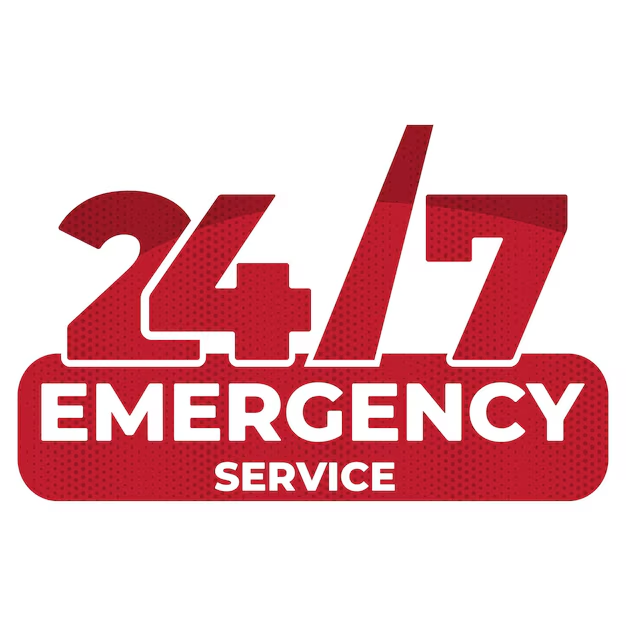A 24-hour emergency service refers to an emergency response system that operates continuously, 24 hours a day, 7 days a week, to provide immediate assistance for any urgent or life-threatening situations. These services are crucial for providing timely medical, police, fire, or rescue support to individuals in distress, ensuring that no matter when an emergency occurs, help is always available.

Key Components of 24-Hour Emergency Services
- Emergency Medical Services (EMS)
- Ambulances and Paramedics: 24-hour emergency medical services (EMS) are available to respond to medical emergencies, including accidents, heart attacks, strokes, and other urgent health situations. Ambulances are staffed with EMTs (Emergency Medical Technicians) or paramedics who provide life-saving care before transporting patients to hospitals.
- Emergency Rooms (ERs): Hospitals with 24-hour emergency departments (ERs) are prepared to handle a wide range of medical emergencies. They have staff and equipment to address critical conditions such as trauma, cardiac events, and strokes.
- Triage: When you arrive at an emergency room, the triage system prioritizes patients based on the severity of their condition, ensuring that life-threatening emergencies are addressed first.
- Emergency Services by Police
- Law Enforcement: Police stations provide 24-hour emergency support for crime-related issues, traffic accidents, disputes, or any situations requiring law enforcement intervention. In emergencies like break-ins, assaults, or threats, police can respond rapidly to ensure safety and take action.
- 911/112 Emergency Numbers: In many countries, emergency response systems can be accessed by dialing emergency numbers like 911 (U.S.), 112 (Europe), or 999 (UK). These services are operational 24/7 and are the first point of contact in many emergency situations.
- Fire and Rescue Services
- Firefighting Services: Fire departments are on standby 24 hours a day to respond to fires, accidents, and disasters. Firefighters are equipped to handle situations involving building fires, forest fires, or vehicle fires, and they also provide rescue operations in case of trapped individuals.
- Search and Rescue: Specialized teams within fire and emergency services may respond to situations requiring search and rescue efforts, such as after natural disasters, in collapsed buildings, or during water rescues.
- Disaster Response and Management
- Natural Disasters: 24-hour emergency services are critical during natural disasters such as earthquakes, floods, hurricanes, or tornadoes. These services involve search-and-rescue teams, disaster relief units, and medical teams to provide immediate help, evacuation, and care to affected individuals.
- Hazardous Materials (HAZMAT): Emergency response teams trained in hazardous materials (HAZMAT) are available 24 hours a day to deal with chemical spills, toxic leaks, and biological threats.
- Emergency Counseling and Support Services
- Crisis Helplines: Many regions offer 24-hour crisis hotlines for mental health support, suicide prevention, domestic violence, and other personal emergencies. These services offer confidential, immediate assistance for individuals in distress.
- Domestic Violence and Abuse Support: Shelters and support services for victims of domestic violence often operate around the clock, providing safety, shelter, and legal support to those in need.
How 24-Hour Emergency Services Work
- Access and Contact
- Most 24-hour emergency services can be accessed through a universal emergency number like 911 (U.S.), 112 (Europe), or 999 (UK), where operators are available around the clock to take calls and dispatch appropriate services based on the nature of the emergency.
- Upon dialing the emergency number, the dispatcher will quickly assess the situation, determine the level of urgency, and send the appropriate resources—be it police, fire, medical services, or rescue teams.
- Coordination Among Agencies
- Often, multiple emergency services work together to respond to a single event, such as a car accident or a natural disaster. For example, police may secure a scene, firefighters may extinguish fires or rescue people, and EMS may transport the injured to the hospital.
- Coordination between hospitals, emergency rooms, and specialized care units is also essential for ensuring patients get the proper treatment as quickly as possible.
- Response Times
- The effectiveness of a 24-hour emergency service is largely dependent on response times. For medical emergencies, timely intervention is critical. Many regions have target response times, such as within 8 minutes for EMS to reach a scene in urban areas.
- For fire and rescue services, prompt response is equally important, especially in situations involving building fires or road accidents.
- Emergency Room (ER) Readiness
- Hospitals with 24-hour ERs are always staffed with a team of physicians, nurses, and support personnel. This ensures they can treat a wide range of emergencies, from trauma and heart attacks to strokes and poisoning.
- Triage systems are used to prioritize patients based on the severity of their condition. This ensures that patients with the most critical conditions are treated first.
- Technology and Support Systems
- Modern 24-hour emergency services often use advanced technology to enhance their operations. For example, GPS tracking systems help ambulances and fire trucks reach their destinations faster.
- Telemedicine is also becoming more common in 24-hour emergency services, allowing patients to consult with doctors remotely in critical situations before they reach the hospital.
Benefits of 24-Hour Emergency Services
- Timely Response: Immediate response to emergencies ensures that individuals receive the necessary care and help as quickly as possible, improving outcomes, especially in life-threatening situations like heart attacks, strokes, or trauma.
- Availability Anytime: The round-the-clock availability of emergency services ensures that no matter when an emergency happens—whether it’s day or night—help is always available.
- Access to Specialists: Many 24-hour emergency services provide access to specialized care that may be required in complex emergencies, such as trauma surgeons, cardiologists, or pediatricians, ensuring patients get the best care possible in critical situations.
- Increased Survival Rates: Prompt medical intervention, particularly in cases of cardiac arrest, trauma, or severe bleeding, increases survival rates. The faster the emergency medical team can intervene, the better the chances of recovery.
- Emergency Preparedness: 24-hour emergency services are crucial in regions prone to disasters, ensuring that there is a prepared and coordinated response to hurricanes, earthquakes, wildfires, and other large-scale emergencies.
Types of Emergencies Handled by 24-Hour Services
- Medical Emergencies:
- Heart attacks
- Strokes
- Trauma (e.g., car accidents, falls)
- Breathing difficulties
- Allergic reactions (e.g., anaphylaxis)
- Drug overdoses
- Childbirth-related emergencies
- Fire Emergencies:
- Building fires
- Wildfires
- Vehicle fires
- Gas leaks or explosions
- Rescue from collapsed buildings
- Police and Law Enforcement:
- Break-ins
- Assaults or domestic violence
- Traffic accidents
- Criminal activities
- Missing persons
- Natural Disasters:
- Earthquakes
- Floods
- Tornadoes
- Hurricanes or typhoons
- Landslides or avalanches
- Mental Health Crises:
- Suicidal tendencies
- Anxiety or panic attacks
- Substance abuse issues
- Domestic violence victims
- Emotional crises
